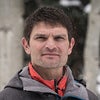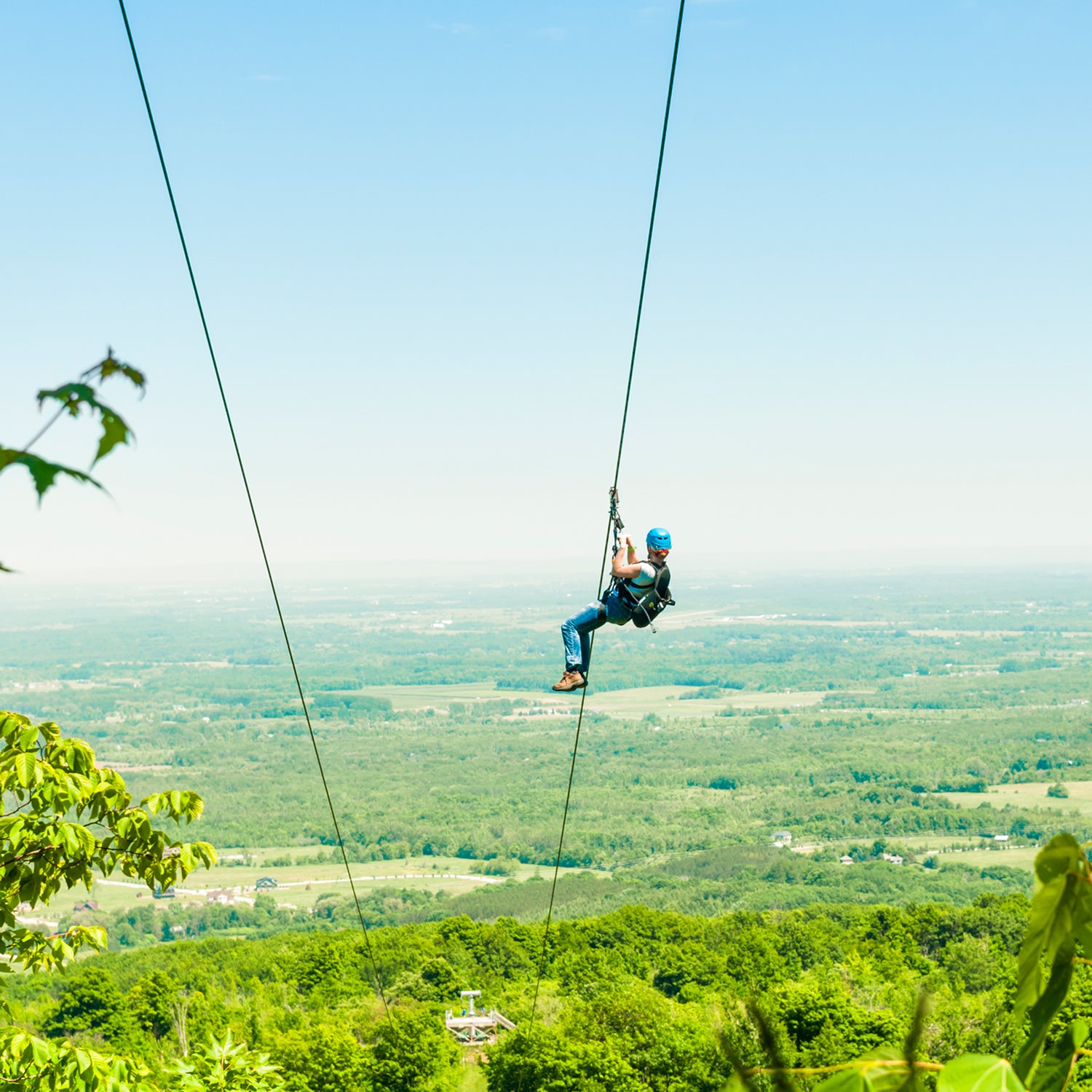In hindsight, John Hines concedes, the idea seems simple: build an aerial adventure park on a flat swath of forested land near a major city, and charge an entrance fee. “Anywhere there are lots of people and lots of trees, there’s an opportunity,” says Hines, co-owner of Outdoor Venture Group, a company founded in 2008 that owns nine parks in six states.
A decade ago, not a single aerial adventure park existed in the United States. They had flourished in Europe, where urban adventurers flocked by the tens of thousands to test themselves on the wood-and-rope challenge courses suspended among the treetops, 50 feet above the ground. Similar structures succeeded for decades in America as team-building venues for corporations and kids. But until Adirondack Extreme, in Lake George, New York, opened the first publicly available pay-to-play park in 2007, nobody had tested whether it was a model that could work in the United States.*
Today, we have our answer: there are anywhere from 200 to 450 aerial adventure parks in the United States, depending whom you ask. (Nobody tracks the numbers for this nascent industry.) In addition to aerial parks, many of these venues offer other contrived activities like zip lines, canopy tours, and mini-roller coasters. And more are on the way.
“It’s just going gangbusters all over the place,” says Paul Cummings, president of Strategic �����ԹϺ���s, which has built a business out of helping people open aerial parks but doesn’t construct them or operate them. (The company conducts feasibility studies, consults on business plans, and coordinates investor meetings.) “I’m getting probably ten to 12 calls per week from people wanting to talk about whether they can open a park, from the Caribbean to Canada. Right now, we’ve got six projects pending in California alone.”
Cummings believes aerial adventure parks serve as “gateways to the natural world.” “People who aren’t necessarily outdoorsy people come and have fun outside.��They leave thinking, ‘Man, we should go hiking. Let’s go outside again.’ If somebody wants an adventure, this is an opportunity to do it without having to travel far.”
In general, an aerial adventure park operates in one of two ways: like a ski area, where everyone climbs a ladder to the same platform and chooses which “trail”—color coded by difficulty—to take from there, or like a golf course, where everyone follows the same progression of trails in a circuit.��
Participants wear safety harnesses and are usually clipped in via carabiners that often work in tandem, with one not releasing until the other is secured. Most parks are open to kids as young as eight years old and offer easier courses built just for them.
The business model is generally predictable, as long as the park is constructed in a high-density area. It costs about $750,000 to $1 million to build a park, but aside from the materials, you don’t need much more than five to eight acres of land, some bathrooms, and power to a registration shed. “You’re probably looking at a 30 percent net profit on average,” Cummings says.��
Often parks will lease vacant land from nonprofit groups and enter into a revenue-sharing agreement. A park in Sandy Spring, Maryland, for example, is located on land owned by the Sandy Spring Friends School, which uses the money to provide financial aid to students. With 18 trails and more than 200 features, the park is one of the nation’s largest and busiest. A season pass runs $780—$29 less than it costs for unlimited skiing or snowboarding at 12 world-class resorts on Vail Resorts’ Epic Pass—and patrons wait in lines for hours.��
Hines estimates the Sandy Spring park, the second one built by Outdoor Venture, sees 80,000 “climbers” in a season, many paying the $53 three-hour usage fee, and says the company’s nine parks cater to 450,000 visitors in total. CrossFitters love them. So do summer camps. Last year, a 95-year-old woman completed one of the courses at Sandy Spring. It’s a far cry from when parks weren’t open to the public and were viewed strictly as a place where groups became more cohesive.��
“When we started, we were the black sheep, because we weren’t educators, team builders, or facilitators,” Hines says. “We were in it for all the wrong reasons. Well, in the past seven years, the entire world has changed, and virtually everybody is now dependent on the revenue that can be generated from the non-team-building, pay-to-play stuff.”
Despite the industry’s growth, questions remain about how the market will evolve. There is no official regulatory agency overseeing the courses or their safety; instead, when a new course is constructed, local government and insurance agencies rely on inspectors accredited with the Association for Challenge Course Technology (ACCT) to deem the course safe and up to industry standards.
“Every state is different,” Hines says. “Some states hold adventure parks to amusement park standards. Some states look at them and go, ‘We don’t know what you are; therefore, we’re just going to watch.’”
“It’s kind of a patchwork regulatory framework that does not exactly fit,” says Shawn Tierney, president of AACT. “So what we try to do is be involved in the regulation of the industry so we can educate regulators but also have other stakeholders, like the operators, be involved, so that whatever regulation there is really makes sense. It’s still in the process of evolving and will be for years.”
No agency, public or private, tracks accidents and deaths, though they are rare. Last year, a teenager died after falling at a newly opened aerial park in Knoxville, Tennessee, where he was found hanging from a log with his harness around his neck. State officials subsequently closed the park, but an ACCT-certified inspector the park to be safe. An autopsy revealed that the teen died of heart disease, not strangulation.
“If you compare this industry to other high-risk industries like climbing, mountaineering, heli-skiing, or programs like NOLS and Outward Bound, I think the number of accidents would look drastically lower,” says Tierney, a former professional mountain guide who has climbed in the Himalayas and Patagonia. Still, some within the industry wonder whether a couple accidents might jeopardize the freedom with which they operate. “We’re trying to gather more data because we need it to show [potential] regulators that we do have a very good risk-management structure in place,” says Tierney.
It is probably not an accident that the rise in aerial adventure parks coincides with the explosion in popularity of obstacle-course racing, CrossFit, and TV shows like American Ninja Warrior. As Hines points out, although parks are popping up at ski resorts and in other tourist venues, most devotees have incorporated them into their daily and weekly routines.
“I’m not competing for vacation money,” Hines says. “My competition is the couch, going bowling, going to a movie theater, going out to dinner, doing nothing. It’s a lifestyle thing.”
Sports psychologist Mark Aoyogi, however, isn’t so sure that’s healthy. There is something to be gained by climbing a mountain instead of a ladder in the trees while harnessed to a rope, he argues.��
“Our world has become so safe. And I’m a parent, so I get this, but I think parents get pulled into this idea that they should never put their kids at risk or in harm’s way,” says Aoyogi, director of sport and performance psychology at the University of Denver. “So instead of having them be outdoors in an uncontrolled environment where who knows what can happen, you put them in a semi-controlled environment where you still don’t know what can happen.” In other words, maybe parents should forgo contrived adventures and let their kids climb real mountains, even if it takes longer to get there.
Aoyogi makes a fair point, but convenience trumps style in this trend. The aerial adventure park market is “not even close” to saturation, Hines says. “I wouldn’t be surprised if five years from now there were 1,500 parks in the U.S.” Cummings predicts growing popularity will require them to adopt reservation systems.
“At a well-designed adventure park,” Hines says, “there’s always something to come back and do.”
CORRECTION: A previous version of this article incorrectly stated that Catamount Ski Area, in New York’s Berkshire Mountains, opened the first publicly available pay-to-play model in 2009.


